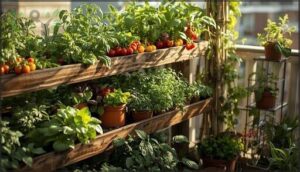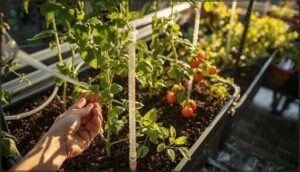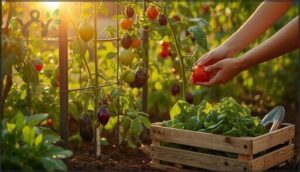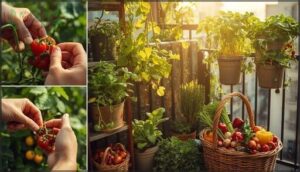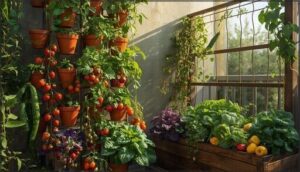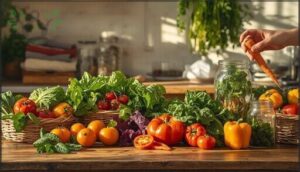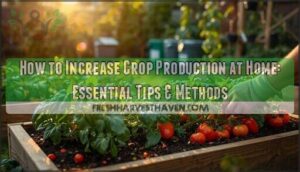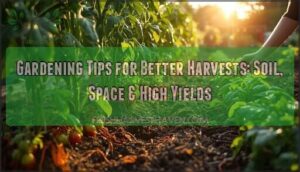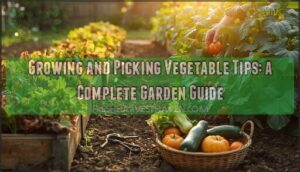This site is supported by our readers. We may earn a commission, at no cost to you, if you purchase through links.
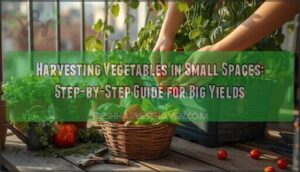
You don’t need acres—just pay attention to color and size cues when crops are ready.
Use compact pruners or even your fingers to snip or pick; those tight corners make you nimble.
Water in the morning, grab veggies early for crisp flavors, and clean with cool water.
With the right containers and sunlight, harvesting feels like picking treasure from your own green corner, whether that’s a balcony or an edge of your patio, maximizing those tasty yields in tiny spots.
Stick around—there’s more to uncover about maximizing those tasty yields in tiny spots.
Table Of Contents
- Key Takeaways
- Planning Your Small Space Vegetable Garden
- Selecting Crops Suited for Small Spaces
- Optimizing Sunlight, Water, and Growing Medium
- Harvest Timing and Preparation
- Step-by-Step Vegetable Harvesting Techniques
- Maximizing Yield in Limited Garden Spaces
- Post-Harvest Care, Storage, and Preservation
- Frequently Asked Questions (FAQs)
- What is the rule of 3 in gardening?
- What vegetables can you grow in small spaces?
- What is the gardening 3 year rule?
- What is one strategy for getting more produce out of a small garden?
- How do I prevent pests in container gardens?
- When is the best time to plant vegetables?
- Can I grow vegetables indoors year-round successfully?
- What fertilizers work best for container vegetables?
- How do I know when vegetables are ready?
- How to prevent pests during small-space vegetable harvests?
- Conclusion
Key Takeaways
- Plan every inch of your space—use vertical setups, container groupings, and smart layouts for bigger yields, even in tiny gardens.
- Choose quick-growing crops and stick with dwarf or compact varieties that thrive in small spots without sprawling.
- Harvest early in the morning for tastier, crisper veggies; watch for color, firmness, and size to know when each crop’s ready.
- Keep your harvest fresh by cleaning produce gently, storing it right, and planting new crops as soon as one’s done to keep the bounty coming and maintain high-yield results.
Planning Your Small Space Vegetable Garden
You’ll need to plan your garden layout, choose the right containers, and match each plant to its ideal space.
Careful planning helps you use every inch efficiently for bigger yields, even in the smallest garden.
Layout Considerations for Limited Areas
Space Optimization is key for vegetable gardening in tight spots. Think Garden Design like a puzzle—every piece counts.
Every inch matters—turn your small space into a thriving, high-yield garden puzzle
Use Vertical Structures to grow up, not out. Container Grouping saves room and keeps harvest timing simple.
Don’t forget Path Efficiency; narrow walkways mean more planting space. With smart planning, you’ll harvest more vegetables from your small garden than you’d expect.
- Maximize corners and edges
- Stack pots and trellises vertically
- Cluster containers by crop needs
- Design narrow, direct paths
Choosing The Right Containers
After mapping your garden, picking the right containers is next.
Container Material affects root health, while Drainage Solutions prevent soggy disasters.
Size Matters for growth, and Container Depth supports strong vegetables.
Mobility Options let you chase the sun for perfect Harvest Timing.
Many gardeners find success using specialized drainage products for containers.
Here’s a quick guide:
| Container Material | Drainage Solutions |
|---|---|
| Clay | Holes |
| Plastic | Rocks |
| Wood | Mesh |
| Fabric | Self-watering |
| Metal | Elevation |
Matching Container Size to Plant Size
You’ve picked your containers, now let’s match them to your vegetables. Root Space and Container Depth matter for healthy growth and easy harvesting.
Think about Plant Needs—tomatoes need more room than lettuce. Drainage Matters, so pick pots with holes. Dwarf Varieties are great for small spaces.
Here’s a quick checklist:
- Match root space to plant needs
- Verify proper container depth
- Check drainage
- Choose dwarf varieties
Selecting Crops Suited for Small Spaces
You’ll get the best results in a small garden by picking vegetables that grow quickly and produce a lot, even in tight spaces.
Choosing crops suited for compact areas lets you maximize your harvest without wasting room.
Best Vegetables for Compact Gardens
Once you’ve mapped out your garden, it’s time to choose the best vegetables for compact gardens.
Dwarf Varieties, Bush Beans, Patio Tomatoes, Salad Greens, and Compact Peppers all thrive in small spaces.
These vegetables don’t sprawl, making harvesting and vegetable gardening easier.
Consider high-yield carrot options for maximum productivity.
With the right choices, you’ll fill your garden with productive plants and maximize every inch.
High-Yield and Fast-Growing Varieties
Many Fast-Growing Veggies and High-Yielding Crops fit snugly into small gardens.
Compact Varieties like bush beans, cherry tomatoes, radishes, and zucchini give you Quick Harvests and steady picking.
These Space-Saving Plants keep your table loaded and encourage repeat vegetable harvesting.
Try mixing several types so you’re always ready for an easy harvest with simple harvesting techniques.
Consider incorporating mini-vegetable ideas for even more efficient use of limited space.
Companion Planting and Vertical Intercropping
After exploring high-yield crops, look at companion planting and vertical intercropping to maximize your garden’s harvest.
Pairing vegetables by Synergistic Combinations boosts Pest Control, Nutrient Cycling, Space Efficiency, and Yield Maximization.
Here’s how your small space can work like a team:
- Peas climbing corn stalks
- Basil thriving near tomatoes
- Carrots enjoying onions’ company
- Lettuce under cucumber vines
Optimizing Sunlight, Water, and Growing Medium
To get the best results in a small garden, you need to manage sunlight, water, and growing medium with care.
Each choice affects plant health, so understanding your space and resources helps you grow more vegetables efficiently.
To achieve this, consider the overall impact of your decisions on the garden’s ecosystem.
Sunlight Placement and Orientation
Getting the hang of sunlight optimization brings your vegetable harvesting dreams within reach.
Mastering sunlight turns even the tiniest garden into a thriving harvest haven bursting with fresh vegetables
Pay attention to solar angles—plants need at least six hours of direct light. Smart shade management keeps leafy greens happy while fruiting crops love full exposure.
Try light reflection tricks, like placing foil near plants. Simple orientation tips can turn a small garden into a seasonal gathering spot for big harvests.
Understanding partial sun conditions is essential for selecting the right crops for your garden.
Efficient Watering Methods for Small Gardens
Once you’ve figured out the best sunlight spots, it’s time to focus on watering.
Stick with Drip Irrigation systems for steady Soil Moisture without waste.
Water Conservation matters, so collect rainwater or even reuse Grey Water when safe.
These methods keep your garden thriving, cut down on effort, and support crop management, easy vegetable harvesting, and overall garden maintenance.
Soil Selection and Mel’s Mix Benefits
After sorting your watering system, soil composition becomes the backbone of garden maintenance.
Choosing the right mix recipes—like Mel’s Mix—streamlines fertilizer needs and delivers exceptional compost benefits.
Its balance of compost, vermiculite, and peat moss supports root optimization, letting crops flourish in containers.
This method boosts vegetable harvesting results, reduces fuss, and sets you up for a plentiful harvest with exceptional compost benefits.
Using Hydroponics and Aeroponics
With hydroponics and aeroponics, you’ll harvest vegetables with less water and space.
Indoor lighting and vertical hydroponics optimize every inch for growth. Keep nutrient solutions fresh for happy plants, and check equipment often for system maintenance.
Aeroponic rooting speeds up development and reduces pests, giving you crisp vegetables faster. Aeroponics also enhances yields by improving nutrient and oxygen delivery directly to the roots.
- Save time
- Grow anywhere
- Boost yields
- Minimize mess
Harvest Timing and Preparation
Getting the timing right helps you bring in the freshest vegetables and avoid wasting your efforts.
You’ll learn what to look for, when to harvest, and how to prepare, so every crop gives you the best results in a small space.
Recognizing Vegetable Maturity
Anyone can spot when harvest time is near by watching for visual cues.
Bright color, firm texture, and the right size matter.
Squeeze or tap for texture tests.
Taste testing a sample never hurts if you’re unsure.
Keep days to maturity in mind; seed packets will tell you.
Use sight and touch often to judge vegetables’ garden readiness.
Morning harvests can help maximize flavor and nutrition.
Best Times of Day to Harvest
A quiet, dewy morning often wins the prize for harvest time.
Morning vs evening can matter: Sunlight intensity is lower at dawn, helping vegetables stay crisp with better plant hydration.
Cooler temperatures slow wilting, letting you catch each crop at peak ripeness.
Manual harvesting during these hours keeps your garden’s bounty fresh and full of flavor.
Tools for Harvesting in Tight Spaces
When harvesting vegetables in a tight garden, compact pruners and micro shears fit easily between stems.
Telescopic tools reach awkward spots, helping you gather every last tomato. Harvesting gloves protect your hands during hand harvesting, while fruit pickers work for taller plants.
These harvesting techniques save space and effort, letting you master your small-space vegetable garden with precision.
Effective use of garden pruning tools is essential for maintaining healthy plants and using garden pruning tools correctly.
Step-by-Step Vegetable Harvesting Techniques
You’ll find clear, practical steps for harvesting vegetables in small spaces, focusing on hand-picking, using tools, and special methods for different crops.
These techniques help you gather your crops efficiently while making the most of every inch in your garden, using complete concepts and practical steps.
Gentle Hand-Picking and Tool Use
After you’ve matched harvest timing to vegetable maturity, focus on gentle handling.
Hand picking is the go-to in small gardens—think of it as careful manual harvesting rather than a race.
Choose tools wisely, like scissors or pruners, for tougher stems, and apply gentle harvest techniques to reduce bruising, protect yield, and make manual labor feel less like a chore.
Crop-Specific Harvesting Guidelines
After tackling gentle hand-picking and tool use, let’s talk specifics.
For perfect Artichoke Harvest, look for tight, firm buds.
Broccoli Timing matters—catch heads before the flowers open.
Carrot Size counts; pull them when they’re about 1-2 inches across.
Cucumber Picking needs vigilance—grab them when skin is glossy.
For a steady Bean Yield, snip pods often.
Cut-and-Come-Again Methods for Greens
For ongoing Green Harvesting and a Continuous Yield of Leafy Greens, the cut-and-come-again method works wonders.
Here’s how you do it:
- Snip outer leaves gently, leaving new centers.
- Water and feed after each gathering to boost regrow techniques.
- Watch for fresh leaves to sprout—manual harvesting keeps vegetable harvesting efficient and bumps up your crop yield.
This approach ensures that you can enjoy a Continuous Yield of fresh leafy greens from your garden.
Maximizing Yield in Limited Garden Spaces
You can boost your garden’s harvest even when space is tight by using strategies like succession planting and vertical setups.
Focus on efficient planting methods to get more produce from every square foot, making every inch count.
Succession Planting for Extended Harvests
When you master gentle hand-picking, it’s time to stretch your harvest season.
Succession planting lets you stagger crops using smart Plant Scheduling. By rotating crops and picking the right seeds, you’ll maximize your garden’s yield, keep fresh veggies coming, and avoid empty patches.
Think of it as giving your vegetable harvesting calendar a steady pulse all season long. This approach relies on understanding succession planting techniques to guarantee a continuous harvest and make the most of your garden’s yield with effective succession planting techniques.
Vertical Farming Systems
Think of your garden as a stack of books—only these are crops.
Aeroponic Systems and Hydroponic Towers let you practice Urban Farming with true Space Optimization.
Vertical Cropping means you can harvest big yields from tight spaces.
These techniques boost Vegetable Harvesting efficiency, conserve water, and keep your crop fresh and close, even without sprawling land, using Vertical Cropping.
Strategies for Repeated Yields
Crop rotation is your garden’s secret handshake—swap veggies’ spots each season for soil renewal and disease control.
For yield optimization, stagger your harvest scheduling so something’s always growing.
Stay sharp with space management: plant quick growers between slow ones.
Vegetable harvesting in rounds keeps your garden busy, and good crop management and maintenance make repeated yields possible, even in tight quarters.
Post-Harvest Care, Storage, and Preservation
After picking your vegetables, you’ll need to clean, store, and preserve them to keep their best flavor and nutrition.
Proper post-harvest care helps reduce waste and makes sure your hard-won harvest lasts longer in your kitchen, which is crucial for maintaining the best flavor.
Cleaning and Handling Fresh Produce
After squeezing every last bit of yield from your small space, focus on cleaning your bounty.
Rinse off soil and bugs—produce washing is key for food safety. Handle fresh veggies gently to prevent bruising, and scrub root crops as needed.
Quick harvest sanitizing with cool water improves crop quality. Careful PostHarvest Handling during cleaning and transporting keeps your vegetables looking and tasting great.
Proper Storage Methods for Vegetables
After cleaning your harvest, how you store vegetables impacts garden crop yield and freshness.
Use these five methods for postharvest handling:
- Root cellars for long-term cool storage.
- Refrigerate in humid containers for crisp greens.
- Store roots in sand for even moisture.
- Use mesh bags for air circulation.
- Practice crop rotation to spread out fresh keeping.
The way you handle your vegetables after harvest is crucial for maintaining their freshness.
Preserving Flavor and Nutritional Value
When you’re aiming for flavor retention and nutrient preservation, timing is key.
To boost crop yield and lock in taste, harvest vegetables during the cool morning, handle crops with care, and use gentle storage methods.
Fast cooling, high humidity, and proper packaging help preserve garden freshness.
Quick processing after harvesting secures both flavor and nutrition for your vegetables.
Frequently Asked Questions (FAQs)
What is the rule of 3 in gardening?
The rule of 3 in gardening means you plant in groups of three—three seeds, three plants, or three rows.
This helps your garden look fuller, boosts pollination, and keeps things tidy and easy to manage.
What vegetables can you grow in small spaces?
You can grow lettuce, spinach, radishes, green onions, bush beans, snap peas, and herbs like basil and parsley in tight quarters.
These crops thrive in containers or small raised beds, making the most of every inch, which is a key concept to thrive in small spaces.
What is the gardening 3 year rule?
Picture planting peppers and peas: the 3-year rule helps you dodge stubborn soil diseases by rotating plant families each year.
Move crops so you’re not growing the same type in the same beds for three years running.
What is one strategy for getting more produce out of a small garden?
Try succession planting—once you finish harvesting one crop, pop new seeds or seedlings in that spot right away.
This keeps your garden beds productive, squeezes in more veggies, and dials up your fresh food supply.
How do I prevent pests in container gardens?
Ever spot tiny bugs throwing a rave in your pots?
Check under leaves, keep soil tidy, and don’t overwater.
Use mesh covers, rotate crops, and invite ladybugs.
Homemade soap sprays also send pests packing without harsh chemicals.
When is the best time to plant vegetables?
You’ll want to plant vegetables after your last frost date in spring.
Cool-season crops like lettuce and carrots go in early, while warm-season types—tomatoes, peppers—wait for steady warmth.
Check your local calendar for the best timing.
Can I grow vegetables indoors year-round successfully?
A windowsill becomes your sunlit stage—yes, vegetables thrive indoors all year long with proper lighting, steady temperatures, and care.
Think of grow lights and good soil as your toolkit.
You’ll harvest fresh produce, rain or shine, with proper lighting.
What fertilizers work best for container vegetables?
Balanced liquid fertilizers labeled for vegetables, such as 10-10-10 or 20-20-20, work well in containers.
Fish emulsion or organic blends also boost growth.
Feed every 2–3 weeks, following label directions, for best results.
How do I know when vegetables are ready?
Check color, firmness, and size; pick tomatoes when red all over, beans when pods snap, and cucumbers when dark green.
Trust your senses and a little nudge—if it slips off easily, it’s harvest time.
How to prevent pests during small-space vegetable harvests?
Harvest in the morning when pests are less active.
Carefully inspect vegetables for bugs, remove damaged leaves, and use mild soapy water to wash produce.
Tight plant spacing? Prune for airflow—pests hate a crowd as much as you do, which helps in maintaining a healthy garden with airflow.
Conclusion
Did you know that small space gardens can produce up to five times more food per square foot than traditional rows?
With smart planning and proper techniques, harvesting vegetables in small spaces isn’t just possible—you can enjoy high yields right from your patio or balcony.
Pay close attention to plant needs, pick at peak ripeness, and store your vegetables correctly.
By using these steps, you’ll get the most flavor and value from every inch of your tiny green space.

